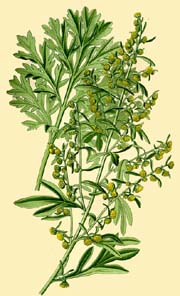 Artemisia absinthium
Artemisia absinthium
Wormwood
Wormwood is said to have sprung up in the track of the Serpent as it left the Garden of Paradise, making it an excellent herb for investigating traditional witchcraft. Considered a Mars herb for its warming properties, Culpeper noted that wormwood tended to be found growing around Martial iron, such as foundries, and that it was good for injuries from "martial" insects like hornets, wasps, and scorpions. In Russian folklore, carrying a sprig of wormwood when traveling through the woods protects against attack by the rusalki, who are armed with iron hooks. This seems similar to wormwood protecting from Martial insects, since iron is a Mars metal.
On the Isle of Man, along with rowan, a seagull's wing feather, and the strip of skin from a conger eel's belly (another snake-like critter), wormwood went into a charm protecting against a pestiferous magical creature called a buggane, a denizen of the earth. Sir Richard Blackmore describes the goddess Bellona (the Roman deity of war, sister/mother/wife of Mars) drinking wormwood and being crowned with snakes. Frazer, with some condescension, tells of Central European peasants making an incense from wormwood, laurel leaves, and holy oil that was intended to remove witches from storm clouds. In ancient Egyptian manuscripts, wormwood is an ingredient in an ink with which one might write a question of the god Bes to be answered in a dream.
Wormwood's flower essence can be helpful in journeying and for initiation into magical paths. The pale color of the leaves make it shimmer in the moonlight, so despite its Mars connection, it is a good Moon Garden plant.
Wormwood grows wild all over Europe and the US. Wormwood's traditional household use in the West has been as a pesticide - to repel bugs from stored clothing and as a strewing herb - as an antiseptic, and the seeds have been taken internally in small amounts to get rid of worms (thus the name). It is also a component of the liquor absinthe. The bitter component of wormwood is an alkaloid, absinthin, which is removed by tincturing (soaking the plant in water or alcohol), but absinthe cannot be made by tincturing wormwood (distilling is required).
Top
How to grow
wormwood
In the US, this
very hardy perennial (lives more than one season)
grows from northern Minnesota to south Florida
(although the Keys are too hot for it). The seeds
are very tiny, so take a pinch between your fingers
and very carefully sprinkle them on sterile moist planting medium,
then gently firm in with your fingertip. Don't bury them, because
they need light to germinate, but as with any seed, do not put them
in direct sunlight. They take a week to
ten days to germinate at room temperature (65-70F/18-22C).
Over 80F/26C and they most likely will not germinate at all. You
can get a jump on their growth by starting them 6-8 weeks before
the last frost in your area. Use mist or bottom watering. They should be
transplanted outside after danger of frost is over
and when they have at least one true set of leaves
(after the first two leaves). Put them in a sunny
or partly shady spot with dry soil and at a
spacing of 2-3ft/60-90cm. Once the plant is
established, you can harvest individual leaves and
dry and store them to use at once, so your plant
will keep producing indefinitely. It can be cut
back to 2ft/60cm the second year of its growth.
This plant gives off chemicals that prevent the
growth of other plants, so it should be on its
own, although we have seen it used for borders. It
grows 4-5ft/1.2-1.5m high when it's happy. That's a lot
of wormwood!
General
growing info.
Top
|
Artemisia absinthium
Wormwood
200 seeds $4.25
This seed cannot be shipped to North Dakota.

Uses in Witchcraft & Magic
Mars Herb
Attack Magic
Honoring Bellona
Protection Spells
Divination/Dreamwork
Path
of the Serpent
Strewing
Go to
the herb
Go
to the essential oil
© 2000-2024 Alchemy Works; No reproduction of any part without permission. |